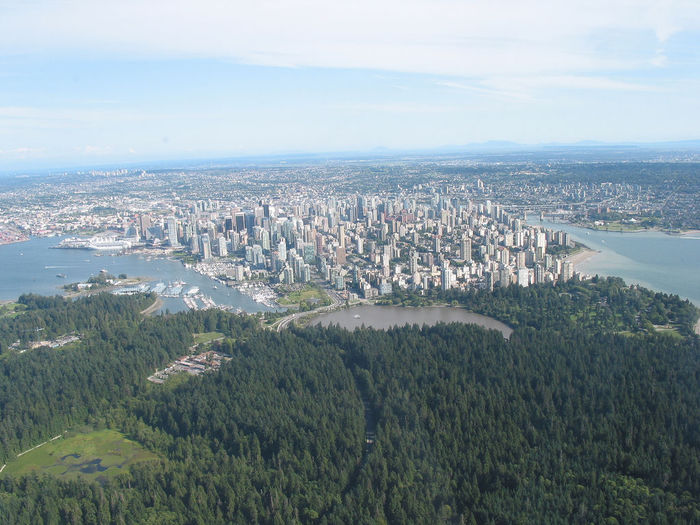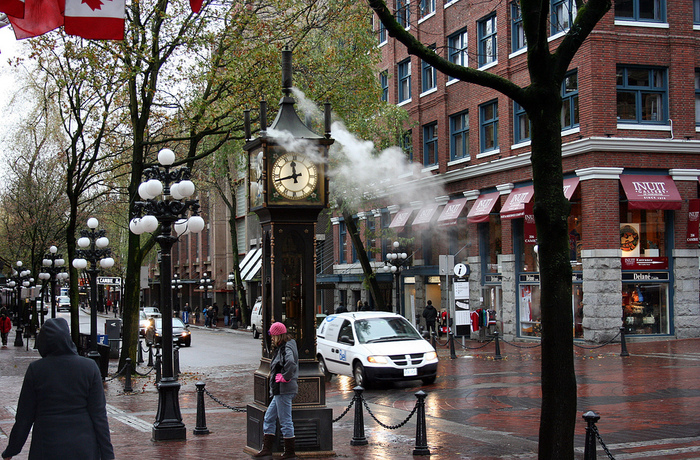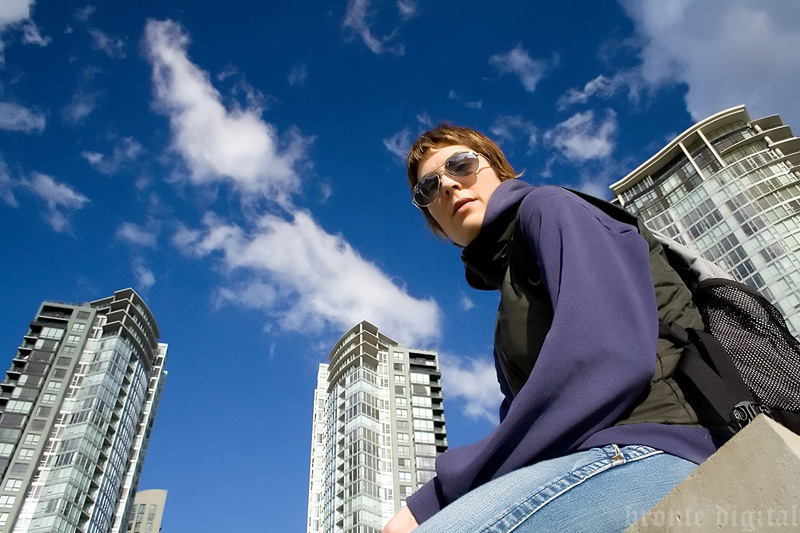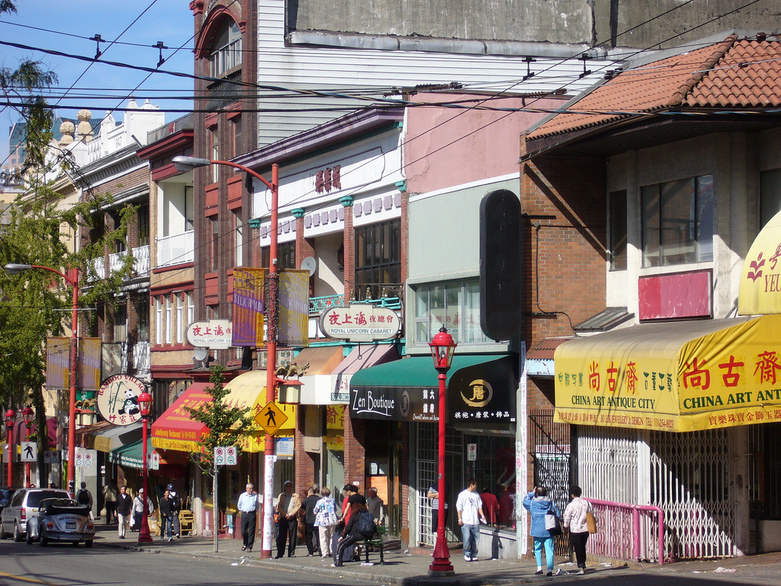Vancouver is a city of neighbourhoods, distinctive, encapsulated, still recognizable after a hundred and twelve years.
Vancouver is a city built along an intact skeleton. The original skull and brainpan centres on and around its harbour. Her arms, the CPR and CNR (now Via) reach inland along either side of the Fraser River. The old BC Electric rail line still traverses Kitsilano and Kerrisdale. It was the spine that delivered white and blue collar workers to mills in Marpole, Grandview and False Creek, to offices, stores and banks Downtown, brought brick from Clayburn, in the Fraser Valley. How many of today’s residents remember the dusty roads and stark red tenement buildings of old Kitsilano which the rails ran through? How many remember kids playing in weedy empty lots, and thick yellow choking fog obliterating the intersection at 16th and Burrard?
Cities suffer growing pains. Vancouver shook when a riot by disillusioned unemployed persons ripped through the heart of the city, during the hash Depression years. Residents had to re evaluate their complacency, that this pretty place on the Warm Ocean was exempt from trouble that rattled older cities. A more recent flare-up marred a summit conference when morally outraged youth demonstrated outside the meeting place, and were summarily dispersed. But let’s be honest here: It’s more likely that the current March of banner and sign bearers has a considerable core of ‘Rent A Mob’ regulars: Frequently groups converge on the lion guarded steps of The Art Gallery to wave their grievances under the noses of hot dog eating passers-by. Tourists pause bemused, lawyers and teachers and office workers don’t pay any attention, but the word does get ‘Out On The Street’. Possibly the winters are too mild, the population too tolerant of differences, yet positive instances of public gatherings are equally frequent.
 Vancouver Stanley Park by cakeordeath
Vancouver Stanley Park by cakeordeath
Central Park area mounts 24 hour marathons for good causes, University Boulevard will feature a bike ride for Cancer cure. Kerrisdale Days tout merchandizing at it expensive best: A long way for any neighbourhood to have come. Housing wealthy immigrants in monster houses, and the grandchildren of its first occupants (their parents fled!), its core is still Forty First Avenue. From its origin as a bungalow district convenient to the tracks for Downtown workers, who boarded the Interuraban with briefcases containing wax paper wrapped chicken sandwiches. They read their morning papers alongside the mill and waterfront workers clutching lunch buckets with garlicky salami and a flask of cold tea. The rail line is still there, but residents plant gardens along the right-of-way, all through its length: Flowery in Kerrisdale, and very vegetable in Kits. Why are we not surprised?
Vancouver grew exponentially during and because of the 1986 Expo. The old mill areas around False Creek were razed, the fact being that cedar cooperage barrels had been pretty well replaced by cast aluminum containers. The old tiny baseball park had been torn out, the factories for steel beams, working gloves, and planing mills made way for temporary structures for the World’s Fair hosted here.
Three immediately visible neighbourhood makeovers cleaned up the downtown centres of the city. Yaletown’s gritty railroad yards, engine roundhouse, and brick warehouses was scrubbed clean. Lofts for artists sprouted in many of the sound old warehouses. The ghastly shaky, substandard rooming houses and tenements were gone, overnight.
Gastown was sanitized, and declared a tourist destination. Its brick and stone structures had originally housed the central business district of the city. Millinery shops, boots and shoes, traditional butchers and bakeries, newspaper plants mingled with lawyers’ offices, hotels and restaurants. Fancy smancy iron lampposts recalling the late 1800’s were erected, flower baskets hung from them, a Steam Clock was added and a statue commemorating the original saloon keeper were displayed as street art.
 The Steam Clock by Lucian Savluc
The Steam Clock by Lucian Savluc
The first of smart residences and offices now occupied Blood Alley and the enclaves off Powell and Carrall Streets. Lovely cafes appeared along newly cobbled streets. International eateries crowded out the old pie and coffee shops that stank of cigarettes and stale cooking oil. In less then a century the area had gone from mud flats crowded with flimsy shacks and shaky transients, denizens of the new colonial dockside area, through respectable merchandizing streets to Tourist Destination! Don’t discount the many bad years in between: The harsh growing pains were dramatized by rundown Single Room Occupancy hotels housing derelicts, drunks and druggies, police presence was standard operating procedure. The anchoring large department stores went out of style, became parking lots and discount stores, and instead of Woodward’s ‘Dollar Forty Nine Day’ bargains, one could buy anything that was wanted, from ‘a good time, Mister?’, to one’s drug of choice.
What’s happening there today? Plywood hoardings mask the old street level single storey shopfronts. The best of the old brick and stone structures are being sand blasted, gutted and redesigned. The Olympics are coming! Squatters have been driven out of the shell of venerable old department store held sway for decades. A somewhat controversial housing project is replacing it: Mixed housing, supposedly including Market Units and some publicly subsidized units. We’ll see.
Yaletown is another story. The artists have been squeezed out. Their lofts have attracted, perhaps even invented, a new breed.‘The Metropolitans’ are among us. Cell phone in one hand, a carry-out Latte in the other, they bustle in their tasseled loafers, and chat and hustle their schemes and dreams. Fashionable, personable, social and driven, they shape their district in a way never seen here before. Over $200 for a ticket to that new show? No problem! $300 for dinner for two? Great! A table at their elegant fine dining retreat? You have to know the Maitre’d.
 Yaletown - by Sam Lewis
Yaletown - by Sam Lewis
Many live in pale hued apartment towers, clustered in graceful garden settings. Pocket parks and tree-lined streets soften the urban construction. The towers probably replicated the height of the tree giants seen by Captain George Vancouver when he sailed into Burrard Inlet in June, 1792.
Elegant clothing shops line Mainland Street, where the horse carts used to back into warehouse loading docks. Black windowed SUV’s and Hummers diagonally park across from imported cosmetic shops and fashionable hair stylist salons. If you have to ask the price, you shouldn’t be shopping here. Portions have been razed, fine towering apartment blocks are arranged in garden settings. You can walk along the waterfront in False Creek, there are green spaces for dogs and kids and sitting. Fish are there, sailboats and yachts, and harbour seals still pop their heads up to see who is walking or biking past. What’s not to like about this area?
Tiny multi coloured ferry boats bob back and fort across False Creek, delivering walkers to Granville Island markets and artisans’ shops. The silver ball of Expo’s Science Museum marks the eastern shore of this salt water bay. Granville Island was the first of the neighbourhood redevelopment projects. The old shingle mills, cooperages, breweries, fish packers were cleaned up. Many of the metal sheds that housed these enterprises are still in use. Special produce vendors, bakeries, fine butcher and seafood shops blend their fragrances and eye-catching colours to tempt resident and visitor alike. Lovely hand crafted wood or pottery pieces alternate with hand painted silks and whimsical greeting cards. Buskers are licensed to entertain in several venues, free for all. Sea gulls will beg, ducks may mach through, people bring dogs and babies and backpacks and bicycles. Residents and visitors can rent a kayak for a water level eyeful of yachts in the marinas on both sides of The Creek. Where labourers toiled forty years ago, people enjoy decadent pastries and take out cappuchino, pushing aside seagulls begging a handout.
Just along this southern slope small industry gave way to medium density housing. Blocks of wildly differing condos, stratas, three storey apartments have replaced the cedar-sided hillside houses of Fairview. South Granville has clustered colourful apartment blocks: Crowds of Vancouverites now bike and walk and bus easily to work in the downtown core, from here and Kits.
Grandview changed the most. Beginning as a farming community, it supplied the first commercial dairy products to Vancouver, ‘way back when downtown was here you lived. The big Grandview Cut of the CPR split it north to south. North? It became more and more the extension of Chinatown, while south filled up with Italian families of all classes. The lovely and culturally active Italian Cultural Centre still reigns, park-set, easily reached by bus and now Skytrain. Large houses, stucco and brick,are enclosed in wrought iron fences, whose gatepost cement lions proudly guard. Neat, neat lawn and flower borders grace all the tree-lined streets, and ‘round the back are tended vegetable gardens and many a wine grape vine.
 Chinatown Vancouver by Caitriana Nicholson
Chinatown Vancouver by Caitriana Nicholson
Chinatown grew, cleaned itself up, and continues to attract residents and visitors. Where else can you find whole smoked ducks hanging in windows, allowing the canny shopper to select the best one for supper? There are street displays of vegetables that have no English names, every shape and colour and type of beans and of rice are in open bins, and sold by the scoopful. The biggest change is that so many of the shoppers no longer live nearby: So many have left this somewhat cramped area and live along Clark Drive and Victoria Drive. Further, they bought up the old berry and vegetable farms on Sea Island, and have created a huge and thriving suburb, Richmond. Talk about change. Asian shopping centres occupy plots where we used to pick our own blueberries. Slick restaurants and karaoke bars have replaced the plant nurseries. Vancouver International Airport traffic screams overhead, while autos and SUV’s and minivans deliver privileged kiddies to music and dance and Mandarin lessons. My old vegetable man, who delivered in a dear, rickety open-sided truck would be unable to find his way home. Mr. Tanaka, the fishman, who came ‘round twice a week has lost his parking places. Both those of his brothers’ fishboat, in Steveston, and his, on his old Gilbert Road holding.
All along the south reaches of Victoria Drive and Knight Road, monster houses have sprung up to meet the needs of recently arriving East Asian families. Pastel behemouths, the span the lot to within the minimum legal few inches lot allowance. Their plaid-kilted daughters shoulder bulging backpacks every morning, and bus themselves off to select academies, which not more than a generation ago had a roomful of only smiling white faces to greet the teachers.
Come visit , and better yet, come and join us, and help Vancouver to grow up into the cosmopolitain city it is well onto the way of becoming.



